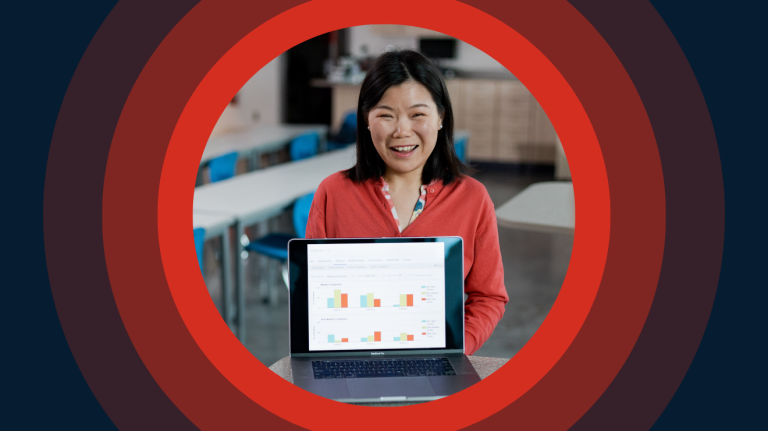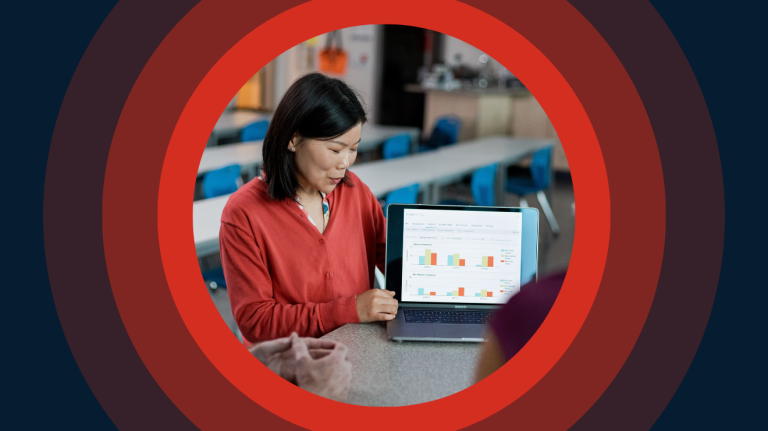Asynchronous learning is a unique approach to education that breaks down barriers of time and place, allowing learners to engage with content at their own pace, on their own schedule, and wherever suits them best. It's more than just a buzzword — it's a transformative strategy that could redefine how we approach education. Whether you're an educator, a student, or someone just intrigued by the evolution of learning, we invite you to dive in and discover how asynchronous learning can significantly enhance the educational experience and improve student performance.
Deciphering the meaning of asynchronous learning
Asynchronous learning, by definition, refers to a student-centred teaching method that uses (usually online) resources to facilitate learning without the need for real-time interaction. Unlike in traditional classrooms, this model doesn't bind students or teachers to a fixed timetable. Instead, it provides flexibility, allowing learners to access educational material at a time that suits them best. This flexibility is one reason asynchronous learning is gaining momentum worldwide as a critical component in the education toolbox.
So, how does this work in practice? Picture a virtual learning environment where students have the freedom to engage with the course material, contribute to online discussions, and complete tasks at their own pace. This doesn't imply learning in isolation, though. Teachers are still instrumental in guiding the educational process, providing feedback, and answering queries — albeit not in real-time.
In an asynchronous setup, diverse online resources are at the heart of the learning process. These might include pre-recorded lectures, online readings, discussion boards, digital assignments, virtual reality media, and interactive quizzes, among others. These resources ensure that despite the lack of immediate, real-time interaction, the learning process remains engaging, effective, and transformative.
It's important to note that while teachers don't provide feedback in real time, many asynchronous setups include the capability for giving instantaneous, computer-generated feedback (scores) on things like quizzes. This can be invaluable as students can receive real-time performance data where they might otherwise have to wait at least overnight before receiving their test scores.
To sum up, asynchronous learning offers a flexible, student-centred approach to education that breaks away from the time and space limitations of traditional synchronous teaching models. As we navigate through the age of digital learning, getting to grips with asynchronous learning can unlock new pathways to drive student engagement, performance, and overall success. Stay tuned to explore the benefits of this innovative learning model in the next section.
Asynchronous vs. synchronous learning — A comparative lens
To help you truly understand what asynchronous learning is, let's compare it to what you might be more familiar with — synchronous learning.
Synchronous learning happens in real-time, with all participants engaging simultaneously. Often this is in a traditional classroom, but it could easily happen via live online sessions. This immediate interaction fosters a dynamic learning environment, allowing for instant feedback and clarification.
In contrast, asynchronous learning occurs independently of when educational materials and delivered or presented, without the constraints of time and location. This model champions flexibility and individual learning paths, fostering a more personalised educational journey.
The core strength of synchronous learning lies in its real-time interaction, fostering immediate engagement and a strong sense of community. On the flip side, it lacks the flexibility asynchronous learning offers, which is crucial for those balancing education with other commitments.
Asynchronous learning shines with its adaptability, providing learning opportunities that fit into diverse schedules and learning styles. However, it may potentially lead to feelings of isolation if not adequately supplemented with collaborative activities.
The real magic happens when we integrate these two models, blending synchronous and asynchronous learning for an optimal educational experience. This combination ensures the social, immediate interaction of synchronous learning, coupled with the flexibility and personalisation asynchronous learning provides. A well-crafted blend can cater to various learning styles, foster student engagement, and facilitate a deeper understanding of the curriculum.
Embracing the benefits of asynchronous learning
In defining asynchronous learning, we've hinted at some of the pros and cons of the approach. Now, let's take a closer look at just some of the many benefits of asynchronous learning and explore how this innovative educational model can significantly enhance learning outcomes.
First and foremost, asynchronous learning champions flexibility. The ability for students to engage with course material on their own timetable accommodates diverse learning styles and personal commitments. Whether a student is an early bird or a night owl, the freedom to learn at a pace that suits them can drastically boost information retention and overall academic performance. It also means teachers can work a lot more flexibly too.
Next, asynchronous learning promotes student autonomy, an invaluable skill for lifelong learning. In an asynchronous setup, learners take the reins, deciding when and how to approach their study material. This fosters a sense of responsibility and self-discipline, essential traits for personal and professional development.
Asynchronous learning also allows for thoughtful participation. Unlike in-class discussions where quick responses are often needed, online platforms provide students with the time to process information, conduct extra research if needed, and craft well-thought-out contributions. This can lead to deeper, more meaningful discussions and a richer learning experience.
This model enables comprehensive and personalised feedback. Computers can deliver instantaneous scores on multiple-choice assessments and educators can provide individual feedback on more complex digital assignments, addressing specific learner's needs and fostering a more personalised learning experience. This tailored approach can enhance students' understanding and performance significantly.
Finally, asynchronous learning can help bridge geographical divides, connecting students from various locations and cultural backgrounds. This creates a multicultural learning environment where diverse perspectives can enrich discussions and broaden learners' horizons.
The benefits of asynchronous learning extend beyond mere convenience. This model promotes autonomy, encourages thoughtful participation, enables personalised feedback, and fosters an inclusive, diverse learning environment. As we continue to leverage digital technologies in education, asynchronous learning can play a pivotal role in enhancing student engagement and success.
Overcoming asynchronous learning disadvantages and hurdles
While asynchronous learning offers a plethora of advantages, as with any other educational model, it isn't without its challenges. Yet, with careful planning and the right tools, educators can successfully overcome asynchronous learning disadvantages to provide a rigorous and engaging educational experience. Let's take a look at the most common hurdles and how they may be overcome.
One potential pitfall is the sense of isolation some students might experience due to the lack of real-time interaction. However, this can be mitigated by building strong online learning communities. Regularly scheduled discussion boards, group projects, and peer-review assignments can encourage engagement and foster a sense of belonging. Blended learning approaches can also give students some real-time interactions with other students and their teachers.
Technology accessibility is another issue that can pose a challenge for asynchronous learning models. Most asynchronous education is delivered digitally (though some distance learning services will mail physical materials), and not all students have equal access to reliable internet or the necessary digital devices. To overcome this, educational institutions can explore partnerships with local businesses or government initiatives to assist students in obtaining the required resources. Educational institutions can also use tools (such as a learning management system) that work well on mobile devices. After all, it's becoming increasingly common for families and individuals to have one or more smartphones but no desktop or laptop computer. Providing tools that allow students to view materials offline is also critical for students with poor internet connections. Schools could also consider an asynchronous-synchronous blended learning approach, mixing online and traditional classroom methods to cater to all learners. A blended approach also means students can download materials while on-campus or at school and then study them at home or on the go.
Another concern is the potential for students to fall behind without the structure of scheduled classes. To address this, educators can set clear expectations and regular deadlines to keep learners on track. Support resources, such as study guides and organisational tools, can also be provided to help students manage their time effectively.
Lastly, the quality and relevance of learning materials are paramount to successful asynchronous learning and educators are often concerned about how engaging materials will be if they're not being taught in person. It'll come as no surprise to you that ensuring resources are engaging, current, and applicable to real-world situations can enhance the learning experience significantly. When materials are delivered asynchronously, tools such as interactive quizzes, video content, and online simulations can be incredibly beneficial. There are even tools like Nearpod, which enable teachers to deliver exciting virtual- and augmented-reality experiences to their students.
So, while challenges in implementing asynchronous learning do exist, they're not insurmountable. With strategic planning, technological support, and engaging content, educators can create a thriving asynchronous learning environment.
Embracing the future of education with asynchronous learning
Asynchronous learning, with its flexibility and adaptability, is reshaping the educational landscape, breaking down traditional boundaries of time and place, and allowing more equitable access to education. It opens up a world of opportunities for learners, tailoring education to individual needs and schedules, and it's an exciting prospect for any educator.
Yes, there are challenges in implementing an asynchronous learning model. And asynchronous learning disadvantages can be more pronounced in certain situations (e.g. younger students will always need some synchronous education). But the benefits of asynchronous learning are many and varied, and there are many ways to incorporate asynchronous learning into a well-rounded, blended learning environment so students and teachers can reap the benefits of both educational methods while mitigating the disadvantages.
As we move forward in this digital age, asynchronous learning stands out as a powerful tool for enhancing education. Now's the perfect time to embark on this journey. So, let's embrace asynchronous learning, and together, we'll make a profound impact on the future of education.
Related Content
 the_five_essentials_for_vocational_learning_platforms.png
the_five_essentials_for_vocational_learning_platforms.pngBlogs
 signs_its_time_to_rethink_your_learning_platform.png
signs_its_time_to_rethink_your_learning_platform.pngBlogs
 from_admin_tool_to_growth_driver.png
from_admin_tool_to_growth_driver.pngBlogs